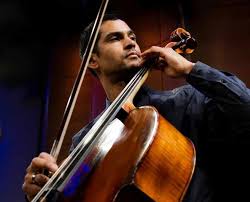by Timothy Robson

Several works on Wednesday’s program included pre-recorded sound, beginning with Andy Akiho’s Three Shades, Foreshadows. Cello pizzicatos blending with the electronics developed into a more rhythmic and percussive second section. Here Zeigler tapped on the body of the cello — and electronic ostinatos slightly out of sync with each other became increasingly complex as the amplified cello was subsumed into the overall texture. Sound enhancement was vivid and well-blended, as it was throughout the concert.
J.G. Thirlwell’s Rubatosis — a medical term for the fear of one’s own heartbeat — is indeed a meditation on that subject. Beginning with long, mournful phrases in minor tonality, Thirlwell uses double stops to create harmony, and often pizzicatos (references to the heartbeat?) under the main melody. The pulse picks up, leading to a section in the cello’s higher register, which accelerates to a climax before returning to the first material. The work has an elegiac atmosphere, almost like a Bach sarabande.
The program featured the world premiere of Randall Woolf’s The Feeling of What Happens. Zeigler described the work as “the human mind in action, and its constant winding and unwinding,” and said that it also includes “fragments from America’s musical past.” The pre-recorded track is derived from bluegrass and country music, a concatenation of banjo and fiddle tunes. Full of glissandos, the cello part functions at first as an obbligato on top of the accompaniment. Eventually the recorded sound comes to dominate, introducing high chirps. Zeigler gave this entrancing work a spectacular performance.
Philip Glass’s Orbit, was perhaps the most conventional work on the program, again making reference to the Bach cello suites. There were tonal phrases of varying lengths, but with more harmonic activity than one sometimes associates with works from Philip Glass’s early career.
Orbit was a momentary ear-cleanser before John Zorn’s ferocious and relentless Babel: The Confusion of Tongues. The music is aggressive and rhythmic, and Zeigler sawed away at full speed and volume for the entire 10-minute piece, occasionally strumming a chopstick inserted in the strings. The cello was greatly amplified to monstrous yet brilliant effect. Jeffrey Zeigler’s performance was an astonishing feat of physicality, clearly recognized by the audience in their cheers and applause at the end.
The recital closed with the most extended work on the concert, Paola Prestini’s Room No. 35. Originally written for Maya Beiser, its eerie and often disquieting sound world is the sonic equivalent of looking into a funhouse mirror. Against a recorded track of low rumblings and gurgles — and what might have been altered human whispers — the soloist plays a duet with a phantom, recorded cello. A lengthy solo section morphs into a chorale with recorded cellos, its more rhythmic pulse underlying passages of intense yearning and rapturous beauty. It is a gorgeous piece.
Published on ClevelandClassical.com May 2, 2017.
Click here for a printable copy of this article



